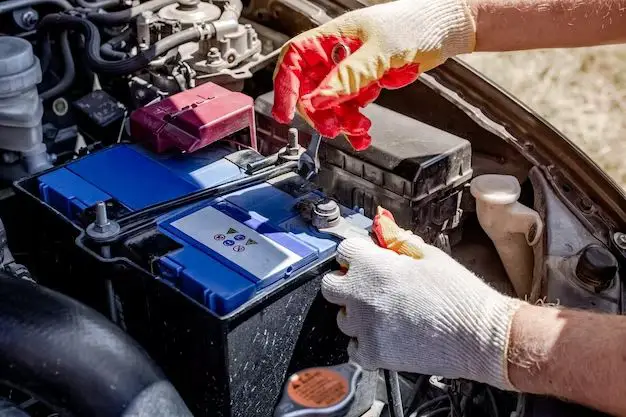Yes, car battery terminals can be replaced. The battery terminals (also called posts or connectors) are the metal parts on top of the battery that connect the battery cables to the battery itself. Over time, these terminals can become corroded or damaged, often from exposure to battery acid or simply from wear and tear. Replacing the terminals is an easy and inexpensive repair that can help extend the life of your battery. In this article, we will discuss the reasons to replace battery terminals, the steps for replacing them, the cost, and some tips for the job.
Page Contents
When to Replace Battery Terminals
Here are some signs that the battery terminals on your car may need to be replaced:
- Corrosion buildup – Corrosion on the terminals interrupts the flow of electricity and can eventually cause the battery not to start the car.
- Frayed cables – Damaged battery cables that connect to the terminals can also disrupt power flow.
- Loose connections – Terminals that are loose or wiggle easily when cables are attached likely need to be replaced.
- Difficulty starting – If turning the key does not start the car right away, corroded or loose terminals could be the reason.
- Dimming headlights – While running, dim headlights or interior lights can signal resistance in the electrical system from bad terminals.
- Battery acid damage – Cracks, pitting, or white powder on terminals likely means damage from battery acid.
If you notice any of those warning signs, it’s a good idea to test the battery terminals or have them inspected by a professional. Replacing them can often get your battery and electrical system working properly again.
Steps for Replacing Battery Terminals
Here is an overview of the step-by-step process for replacing your battery terminals:
- Disconnect the battery – Always disconnect the negative cable first, then the positive cable. This safety step prevents short circuits while you work.
- Remove the cables – Use a wrench to loosen and remove the cable clamps from the terminals. Set them aside where they won’t touch each other.
- Clean the battery posts – Use a wire brush to scrub away any dirt, corrosion, or residue on the battery posts.
- Inspect the posts – Check that the posts are intact and not badly eroded. If the posts need replacement too, you’ll need to replace the whole battery.
- Install new terminals – Place the new terminals on the battery posts. Ensure they fit snugly against the base. Tighten the mounting hardware securely.
- Attach the cables – Reattach the positive cable first, then the negative. Tighten the clamps down firmly so the cables make flush contact.
- Reconnect the battery – Reconnect the negative cable first, then reconnect the positive. The terminals are now successfully replaced!
Having the proper tools like wrenches, a wire brush, gloves, and safety glasses will make the job much easier. It’s also helpful to have a repair manual for your specific vehicle make and model for reference. Be sure to dispose of the old battery terminals properly.
Cost for Replacement
The cost for having your battery terminals replaced can range from $50-$150 for parts and labor. This is just an estimate – prices ultimately depend on:
- Vehicle make and model – More expensive, high-end cars typically cost more.
- Parts pricing – New battery terminal prices range from $10-$50 for the pair.
- Labor fees – Labor typically ranges from $40-$100 per hour.
- Where you have the work done – Dealerships charge more than local repair shops.
- Extent of damage – If more repairs are needed, like posts or cables, that adds to the cost.
- Type of terminals – Some premium, high-copper content terminals can be more expensive.
Doing the very simple replacement job yourself can cost as little as $20-$30 for a new pair of terminals. Having a shop do the full replacement with new cables and labor will run closer to $150.
Tips for Replacing Battery Terminals
Follow these tips to safely replace your battery terminals and ensure successful operation:
- Protect your eyes – Wear safety glasses when hammering, prying, or brushing the terminals.
- Avoid sparks – Sparks could ignite hydrogen gas from the battery. Work away from open flames.
- Rinse with water – After removing the terminals, rinse the battery posts with water to neutralize any remaining acid.
- Apply dielectric grease – Coat the terminals and cable clamps with this grease to prevent future corrosion.
- Check tightness – Double check that the new terminal clamps are tightened properly so connections are secure.
- Test the battery – Use a voltmeter to test the battery state of charge before reconnecting cables.
- Replace in pairs – Always replace both the positive and negative terminals rather than just one.
- Dispose of old parts – Recycle the old terminals and cables to prevent environmental hazards.
Taking precautions for safety and following manufacturer torque specs when tightening will allow the new terminals to last a long time.
Conclusion
Replacing worn or damaged battery terminals is an affordable repair that can often get your vehicle started and electrical system working properly again. Signs like corrosion, loose connections, and difficulty starting are clues that replacement may be needed. The job can be done in just a few steps if you have the right tools and parts. Paying a shop for the repair will cost between $50-$150 depending on the labor time and parts needed. With some basic safety precautions and testing, new battery terminals can have your car battery powered up for years to come.
